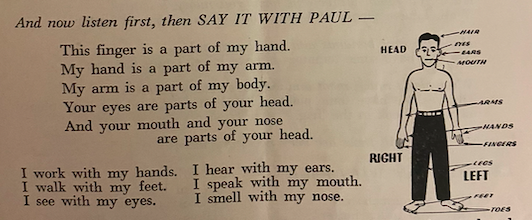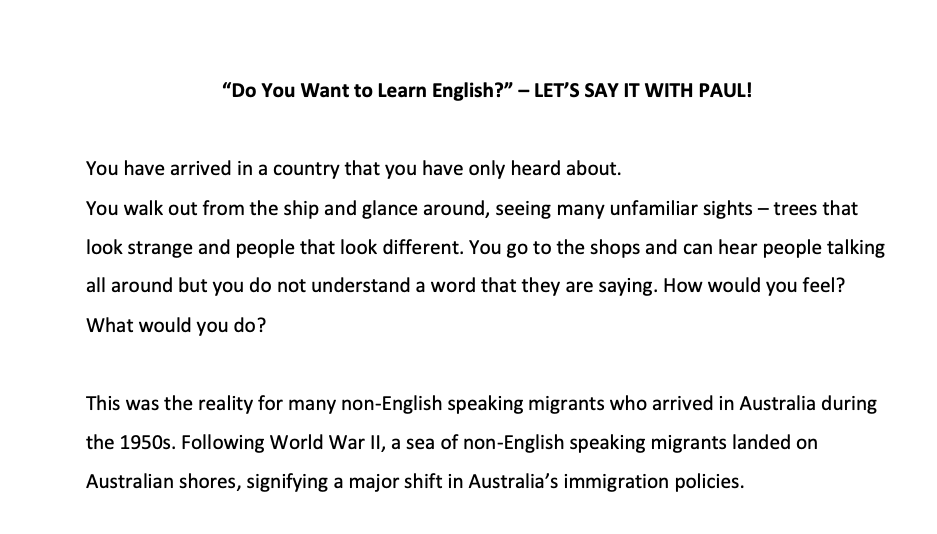
I had the amazing opportunity to collaborate with the Sea Museum and have access a subset collection of radio booklets called, For New Australians (1957/1958). These were government issued booklets that were accompanied by a live radio broadcasted that aired every Saturday in the morning and afternoon. Researching on the radio booklets and migration in Australian in 1950s took me on a grand adventure, from the online archives of Trove and ABC to the hike from Martin Place station to the NSW State Library. In my university life, I have never undertaken research quite like this because I felt like what I was doing mattered.
The main argument of this blogpost is to inform and emphasise to everyday Australians that our history of migrants learning the English language is extremely niche. I hope to show that although the booklets were published in the period where the White Australia policy was slowly vanishing, its residual impact on the general populace of Australia remained. In my research into migration and the White Australia policy, it was evident that our immigration programs were highly planned and targeted a specific type of people. Indeed my research has indicated that non-European migrants, particularly Chinese people were migrating to Australia in the same period. To further add, there were exclusionary practices within the immigration policy that ensured that Australia continued to take in mostly European people. The very fact that Australia Government still continued to perpetuate the White Australia ideology is evident through the radio booklets and its aim to assimilate European migrants. The illustrations and dialogues show listeners/readers the types of people that were welcome here.
The For New Australians (1957/1958) booklet was my main source of evidence for my project that I used to illustrate arguments that were made. The background research conducted on immigration policy was used to inform me on the nature of the society in 1950s Australia and helped frame my argument on the White Australia Policy and the ideology of assimilation. Due to the niche nature of the topic, I searched Trove to find newspapers articles on the For New Australians (1957/1958) booklets/programme, which furthered my understanding in the different ways that migrants learnt English, as well as the intended aims and the nature of the live radio broadcast. Also, my research on the author of the booklets, Elvira Hogg led me on a archival adventure of who she was as a person. I experienced great limitation regarding detailed research into who she was, thus it was required to construct her persona through the writing of others.
The underlying theme of the project was to share with my audience the missing pieces in our collective memory of Australia’s migration history through the radio booklets. This helped me develop my argument that the White Australia policy greatly influenced the lives of migrants and teaching them English was a form of assimilating them into the Australian way of life. Furthermore, the inclusion of excerpts of the scripts in my blogpost provided tangible evidence that strengthened my argument.
There is a need for Australians to understand their migrant history as the present-day Australia would not have existed without immigration. The blogpost serves to reminisce about the past policy of the Australian government to assimilate new arrivals into the Australian way of life. Learning English was a way to indoctrinate migrants into being Australian rather than an acceptance of who they were as individuals with a different language, culture and history. I hope the language of my blogpost is easy to understand for my audience (age 12+) and provides a snapshot into the life of a migrant who learnt English in the 1950s using radio lessons.
Through the publication of the For New Australian (1957/1958) blogpost on the Sea Museum website, people will have a richer understanding of Australia’s complex immigration history. This work was necessary to bridge the gap in everyday Australians’ understanding of post-war migrations. Our current school history curriculum only briefly covers the fact that migrants had to learn English in Australia. The depth of Australia’s post-war migrant history is largely missing the experiences of how non-English migrants had to learn English, which was readily available to them through various schemes organised by the government.
I honestly believe that the creativity of the project is lacking compared to my peers who are completing podcasts, interviews and creating cool videos. Due to the constraints of timing and the needs of the organisation, a blogpost was the best project for this unit. I wanted to include original audio recordings from the radio broadcast, however I am still awaiting a response from the ABC Archives who I have been in contact with. Instead, I’ve decided to include a brief recording of the script that was completed with the aid of people around me. The quality of the recordings was hindered by logistical factors such as gathering people together to record and finding the right person. Hence, the scripts were carefully selected to ensure that I could do my best with the individuals available to complete the recordings.
I have linked the recordings below for those that want to hear it.
For New Australians #92, Jan 1957, p. 7
For New Australians #92, Jan 1957, pp. 18-20
For New Australians #108, May 1958 pp. 18-19
The work will be presented through a blogpost that would be (hopefully) published in the Sea Museum website. Peter was phenomenal to collaborate with as he provided me with the freedom and flexibility of taking the lead on what I wanted to explore. Through much thought, it was decided that a blogpost would be the best option for the both of us. The limited word count and mode of the blogpost form was very challenging. However, for the aim of project which was to inform and garner more awareness of the history these booklets have captured, I believe that the blogpost form was very suitable.
My work will be highly accessible to its intended audience as it will be hosted on the Sea Museum’s official website. I hope that recordings of the script would be also included in the blogpost as I believe it will further engage my audience and allow them to experience having a radio lesson. Furthermore, I will share with my History teaching colleagues the primary sources booklet that I have collated based on 1950s newspaper articles on Australia’s migration and For New Australians radio booklet.
The fact that it will be posted on the Sea Museum website will ensure that my work will be freely available for people who are exploring the online site. Also as a History teacher, I could use the source booklet that I have created in my own classes on Australia’s migration.
Below is a short preview of the blogpost, which is still in the drafting phase.

I just really want to thank Peter Hobbins for providing me with an opportunity to work with such rich primary sources. I feel so much more educated about our migrant history and will endeavour for my future students know about this part of our history.
Personally these radio booklets unearthed long forgotten feelings and memories of being in a new country and having to learn a new language. My earliest memory of Australia was being in a Kindergarten classroom and having difficulties in understanding my teacher. I positioned myself as Paul, the main character of these booklets as he tries to learn English and understand the Australian way of life. In fact while I was scouring through these booklets and researching on the topic, I could not help but think of a song that many of us know.
We are one
But we are many
And from all the lands on earth we come
We’ll share a dream
And sing with one voice
I am, you are, we are Australian.
– The Seekers (1987)
The radio booklets made me deeply reflect on Australia as a nation and how it has changed from one that was excluded the masses to one that can be truly called multicultural.
